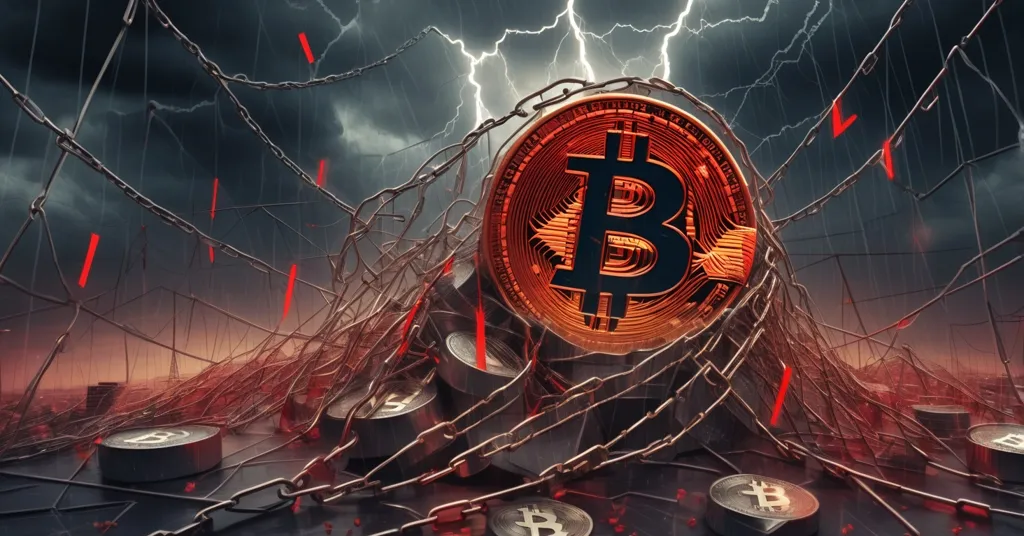Bitcoin Chaos: $19B Crash and $15B DOJ Seizure Shake Crypto World

Historic Crypto Crash and Record DOJ Seizure: Chaos Reigns in Bitcoin’s Wild Week
The cryptocurrency world just endured one of its most brutal weeks yet, with a staggering $19 billion flash crash triggered by geopolitical saber-rattling and the U.S. Department of Justice executing the largest Bitcoin seizure in history, confiscating $15 billion in BTC from a Cambodian scam syndicate. From market meltdowns to shady trades and political intrigue, we’re diving deep into the mess with no punches pulled, exposing both the promise and the perils of this decentralized frontier.
- Market Meltdown: $19 billion liquidated in a flash crash, affecting 1.6 million traders, sparked by Trump’s tariff threat against China.
- DOJ’s Massive Haul: $15 billion in Bitcoin seized from a pig butchering scam linked to Cambodia’s Prince Holding Group.
- Dark Corners: Insider trading allegations on DeFi platforms and speculation over presidential pardons for crypto figures.
A Flash Crash That Crushed the Market
On October 10, the crypto market plummeted into chaos with a flash crash that obliterated $19 billion in leveraged positions across centralized exchanges and decentralized finance (DeFi) platforms like Hyperliquid. For those new to the game, leveraged positions mean borrowing funds to amplify trades, magnifying both gains and devastating losses when the market turns. Over 1.6 million traders were caught in this bloodbath, watching their portfolios vanish in mere hours. The catalyst was a bombshell post on Truth Social by U.S. President Donald Trump, threatening a 100% tariff on China over restrictions on rare earth mineral exports—a critical component for tech and green energy industries. This geopolitical shockwave didn’t just rattle crypto; it sent Bitcoin (BTC) and Ethereum (ETH) into double-digit percentage nosedives while gold and silver prices surged as safe-haven assets, leaving tech stocks and digital currencies in freefall.
Binance, the behemoth of centralized exchanges, buckled under the strain. Outages crippled the platform during peak panic, and a coding glitch displayed token values at $0 due to a misplaced decimal point—a slap in the face to already reeling users. Even stablecoins, designed to hold a steady 1:1 peg to assets like the U.S. dollar, faltered; USDe from Ethena Labs dropped to a measly $0.65 on Binance, proving that “stable” is just a marketing term under extreme stress. Binance responded with a $283 million compensation package for affected users, alongside a $400 million recovery plan and a $45 million airdrop on BNB Chain to restore faith. But let’s cut the crap—these technical failures expose glaring weaknesses in centralized infrastructure. If mass adoption is the goal, how can platforms crumble at the first sign of volatility? Crypto.com CEO Kris Marszalek didn’t mince words on the issue:
“Regulators should look into the exchanges that had most liquidations in the last 24h and conduct a thorough review of fairness of practices.”
Marszalek’s critique hits hard. Leveraged trading has turned parts of crypto into a high-stakes casino, and when the system glitches, the house doesn’t just win—it collapses on everyone. To put this crash in perspective, it echoes past market shocks like the 2021 China mining ban, where BTC dropped 30% in a week due to regulatory crackdowns. Geopolitical triggers are a recurring nightmare for crypto, and until the space builds resilience against such external noise, these wipeouts will keep happening. What’s next? Will exchanges bolster their servers, or are we doomed to repeat this cycle with every global headline?
Binance and Beyond: Infrastructure Under Fire
Centralized exchanges like Binance aren’t just battling user backlash—they’re fighting for credibility. During the crash, server overloads and liquidity crunches likely exacerbated the outages, a common issue when trading volumes spike beyond capacity. Compare this to DeFi platforms like Hyperliquid, which, while not immune to liquidations, often handle volatility through automated protocols without a central point of failure. Yet, even DeFi isn’t a silver bullet, as we’ll see with emerging allegations of foul play. Binance’s hefty compensation and recovery plans are a step forward, but they’re also a band-aid on a deeper wound: the fragility of centralized systems in a space built on the ethos of decentralization. If crypto is to scale, exchanges must invest in robust infrastructure—or risk becoming relics as DeFi evolves. Are centralized platforms ready for the next storm, or will users migrate en masse to trustless systems?
Insider Trading Allegations: A Stain on Crypto’s Credibility
While most traders nursed their losses, one player on Hyperliquid cashed in big, raking $142 million by shorting BTC and ETH just before the crash. For the uninitiated, shorting is betting on a price drop, often through borrowed assets, profiting when the market tanks. Blockchain forensics—tools that trace transactions on public ledgers—linked this windfall to Garrett Jin, founder of the now-defunct BitForex exchange, which allegedly disappeared with $56 million in customer funds years ago. The timing reeks of insider knowledge, though hard evidence remains elusive beyond on-chain correlations. Jin, of course, denies any wrongdoing, claiming no ties to Trump or political insiders:
“I have no connection with the Trump family or [the president] – this isn’t insider trading… the funds backing the trades aren’t mine but belonged to my clients.”
His defense that it’s “client money” doesn’t exactly inspire confidence. Whether it’s insider trading or a lucky gamble, the optics are disastrous for a space already battling perceptions of manipulation. Crypto’s strength is transparency—every trade on most blockchains is public. Yet, without stricter oversight or public trade ledgers on DeFi platforms, these suspicions fester. We can’t preach trustlessness while ignoring potential market rigging. Solutions like mandatory Know-Your-Customer (KYC) checks on DeFi or real-time anomaly detection could deter such behavior, but they clash with privacy ideals. Until the industry tackles this head-on, mainstream trust will remain a pipe dream. Is crypto a fair game, or just a sandbox for the well-connected?
DOJ’s Historic Bitcoin Seizure: Justice or Market Risk?
What Are Pig Butchering Scams?
Amid the market carnage, the U.S. Department of Justice (DOJ) struck a major blow against crypto crime, seizing 127,271 BTC—worth approximately $15 billion—from Chen ‘Vincent’ Zhi, a British-Cambodian national and chairman of Prince Holding Group. Zhi is accused of orchestrating a massive “pig butchering” scam, a vile scheme where fraudsters build trust with victims, often through fake romantic or friendly relationships online, luring them into sham crypto investments. Think of it as a con artist posing as your soulmate, promising small returns to “fatten you up” before draining your savings in one brutal swipe. Operating out of alleged forced-labor compounds in Cambodia, Zhi’s network preyed on countless individuals, showcasing the ugliest side of crypto’s accessibility to criminals. For more on this unprecedented event, check out details on the massive crypto crash and DOJ’s historic BTC seizure.
Strategic Bitcoin Reserve: Boon or Bane?
This seizure marks the DOJ’s largest Bitcoin forfeiture ever, but what happens to this digital fortune now? Enter the U.S. Strategic Bitcoin Reserve, a government initiative endorsed by Trump to hold BTC as a national asset, akin to gold reserves, currently sitting at 198,012 BTC. Senator Cynthia Lummis, a staunch crypto advocate, sees this as a strategic win:
“Turning criminal proceeds into assets that strengthen America’s Strategic Bitcoin Reserve shows how sound policy can turn wrongdoing into lasting national value.”
Her logic holds appeal—transforming criminal gains into national strength is a poetic middle finger to scammers. But here’s the rub: dumping $15 billion in BTC on the market could crater prices, as seen in past auctions like the 2014 Silk Road sale of 30,000 BTC, which briefly dipped prices by 5%. Alternatively, hoarding it for the reserve might fuel bullish sentiment but risks centralizing a decentralized asset—ironic for a tech born to defy control. Then there’s the moral angle: victims of Zhi’s scam deserve restitution before the government stacks sats. Legislation and ownership disputes complicate the path forward. Will this haul stabilize Bitcoin’s legitimacy or just spark another market shock? We’re watching every transaction.
Roger Ver’s Settlement: A Warning to Early Adopters
Shifting to legal reckonings, Roger Ver—once dubbed ‘Bitcoin Jesus’ for evangelizing BTC in its infancy—settled tax evasion charges with the U.S. government for nearly $50 million. Ver admitted to willfully dodging taxes on over $16 million in unreported Bitcoin gains, a stark reminder that even pioneers aren’t above the law. This isn’t just a personal hit; it signals to early adopters that the Wild West days of crypto, when IRS oversight was a distant threat, are history. U.S. authorities are combing through blockchain records, and non-compliance is a ticking time bomb. This echoes past crackdowns like the Mt. Gox fallout, where regulatory blind spots enabled chaos. For OGs sitting on untaxed gains, the message is clear: come clean or face the hammer. Is this accountability a step toward legitimacy, or a chill on crypto’s rebellious roots?
Presidential Pardons: Political Games in Crypto’s Arena
Adding a layer of political spice, speculation swirls around potential presidential pardons for crypto’s fallen giants. Prediction markets like Polymarket and Kalshi peg a 55% chance that Trump might pardon Binance founder Changpeng ‘CZ’ Zhao, convicted of Bank Secrecy Act violations but not fraud—a distinction CZ himself emphasizes:
“Great news if true… there were no ‘fraud’ charges… [Biden-era DOJ] looked very hard for it, but didn’t find any.”
Trump’s pro-crypto rhetoric, from past NFT ventures to campaign nods at Bitcoin, fuels the buzz, and a CZ pardon could signal industry-friendly policy. Meanwhile, Roger Ver’s odds slid to 15% post-settlement, down from 33%, and Sam Bankman-Fried (SBF) of the collapsed FTX exchange hovers at a dismal 4-5%, despite lobbying efforts. Serving a 25-year sentence for fraud tied to billions in customer losses, SBF still pleads innocence from prison:
“You know, I never defrauded anyone.”
Good luck selling that story, Sam. Pardoning CZ might win crypto cheers, but freeing SBF risks public outrage over FTX’s victims. This isn’t new territory—crypto has danced with politics since 2017 ICO bans and Silk Road takedowns. A pardon could reshape regulatory ties, but at what cost to public trust? Are these moves genuine support for innovation, or just populist chess plays?
Key Questions and Takeaways for Crypto Enthusiasts
- What triggered the historic $19 billion Bitcoin market crash?
U.S. President Donald Trump’s threat of 100% tariffs on China over rare earth mineral restrictions sparked panic, exposing crypto’s vulnerability to geopolitical shocks. - How are exchanges like Binance addressing the chaos?
Binance compensated users with $283 million after outages and glitches, alongside a $400 million recovery plan, but infrastructure flaws remain a glaring issue for centralized platforms. - Are insider trading allegations a threat to crypto’s integrity?
Absolutely—a $142 million Hyperliquid short tied to Garrett Jin raises red flags of manipulation, undermining trust unless DeFi transparency and oversight improve. - What’s the impact of the DOJ’s $15 billion Bitcoin seizure?
It’s a major strike against crypto crime via pig butchering scams, but allocating the BTC—whether to the Strategic Bitcoin Reserve or victims—could sway market prices or policy perceptions. - Does Roger Ver’s $50 million tax settlement signal tighter rules?
Without a doubt—U.S. authorities are targeting early Bitcoiners for past evasion, pushing the space toward compliance at the risk of stifling its rebellious edge. - Could presidential pardons shift crypto’s regulatory future?
A pardon for CZ might boost morale and signal leniency, but overlooking SBF’s FTX disaster could alienate the public and derail legitimacy efforts. - How do these events affect long-term crypto adoption?
Crashes and scams deter institutional buy-in, yet reserves and regulatory wins could build trust—analysts are split on a 2024 crypto winter versus BTC hitting $100K if policies hold.
Optimism With Eyes Wide Open: Crypto’s Double-Edged Sword
Let’s step back and assess the wreckage. This week’s turmoil—from a devastating Bitcoin crash to a landmark DOJ seizure—lays bare crypto’s dual nature as both a revolutionary force and a magnet for mayhem. Trump’s tariff threat proves how external noise can demolish over-leveraged markets in hours, while Binance’s stumbles highlight centralized vulnerabilities. Yet, the $15 billion Bitcoin haul shows blockchain’s transparency can expose crime, even if the aftermath poses market risks. Legal battles, from Roger Ver’s settlement to pardon rumors, underscore an ongoing clash between crypto’s free spirit and regulatory reality.
As Bitcoin maximalists, we see BTC’s potential as the ultimate store of value, a defiant stand against fiat control, especially with ideas like the Strategic Bitcoin Reserve gaining traction. But we’re not blind cheerleaders—altcoins and platforms like Ethereum, with its smart contract prowess, and Solana, with lightning-fast transactions, carve out vital niches Bitcoin shouldn’t dominate. DeFi innovation pushes boundaries, even if it’s tainted by shady trades. Pig butchering scams and market manipulation aren’t just bad PR; they’re cancers threatening adoption. And let’s be real—hype-driven price predictions and “moon shot” nonsense peddled by grifters deserve nothing but scorn. We’re here for effective accelerationism, driving decentralized tech to upend the status quo, not to enable frauds.
Practical Tips: Safeguarding Your Crypto Journey
For both newbies and veterans navigating this storm, here are hard-earned lessons. Store long-term holdings in hardware wallets—offline devices that keep your keys safe from hacks. Avoid over-leveraging on exchanges; the thrill of amplified gains isn’t worth the wipeout risk. And beware unsolicited “friends” pitching crypto goldmines online—pig butchering scams thrive on trust. Knowledge is your shield; question every narrative, even the bullish ones.
The Road Ahead: Freedom Versus Fragility
So, where does crypto stand after this rollercoaster? We remain bullish on Bitcoin and blockchain as the future of money, privacy, and freedom—a direct challenge to centralized power. But the path is riddled with obstacles: geopolitical shocks, technical failures, and human greed top the list. Some skeptics even warn that government reserves risk turning BTC into a controlled asset, betraying its decentralized soul. Could state hoarding be as toxic as corporate manipulation? It’s a question worth chewing on. We’ll keep championing the good while exposing the rot, because if crypto is to reshape the world, it must do so with integrity, not illusions. Stay sharp—we’re tracking every twist in this saga.



